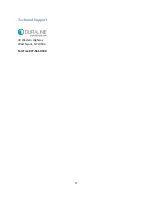
6
Equipment Specifications
Tank
Capacity
Ultrasonic
Frequency
Khz
Tank Dimensions
(L x W x H)
Weight
Power
Supply
U.S.
Power
(Watts
Peak)
Warranty
Heat (w/
Temp
Control)
Fuse
Size
Amp
11 Liter
40 Khz
12” x 9” x 6”
(L x W x H)
40 lbs.
AC 100 ~
120v, 50 /
60Hz
400 W
1yr prts/lbr
+ 1 yr parts.
Yes
8
15 Liter
40 Khz
11.5” x 11” x 8”
(L x W x H)
40 lbs.
AC 100 ~
120v, 50 /
60Hz
500 W
1yr prts/lbr
+ 1 yr parts.
Yes
10
20 Liter
40 Khz
12.25” x 11” x 10”
(L x W x H)
40 lbs.
AC 100 ~
120v, 50 /
60Hz
500 W
1yr prts/lbr
+ 1 yr parts.
Yes
10
25 Liter
40 Khz
18.5” x 11.5” x 8”
(L x W x H)
60 lbs.
AC 100 ~
120v, 50 /
60Hz
600 W
1yr prts/lbr
+ 1 yr parts.
Yes
15
10 Gallon
40 Khz
19.5” x 11” x 10”
(L x W x H)
60 lbs.
AC 100 ~
120v, 50 /
60Hz
720/960 W
1yr prts/lbr
+ 1 yr parts.
Yes
15
How Ultrasonics Work
Dirty items come clean in ultrasonic cleaning systems when millions of superheated
bubbles scrub grime and oxidation away with stunning results. How? Through the
process of de-cavitation.
Ultrasonic cleaning systems send high frequency sound waves ripping through an
ultrasonic cleaning solution leaving super
heated bubbles in the waves’ wake. When
these bubbles, called cavitations, collapse, called decavitation, the heat and energy of
their implosions work with the specially formulated ultrasonic cleaning solution to
remove dirt, oils, residue, and oxidation from the surface of the contaminated item.
Imagine the ability to get into the tiniest of nooks and crannies where dirt and grime
hide, and then imagine scrubbing that surface ultra clean. With conventional cleaning
–
brushes, rags and elbow grease
– this task seems impossible. But the cavitating
cleaning action of an ultrasonic cleaning system does just that
– It goes where brush
bristles can’t.
What is Ultrasonic Cleaning Technology?
Ultrasonic cleaning technology is high frequency sound waves creating a phenomenon
in a fluid called cavitating action, or cavitations. Cavitations, the superheated bursting of
bubbles in a fluid, are what make ultrasonic cleaning work.



































